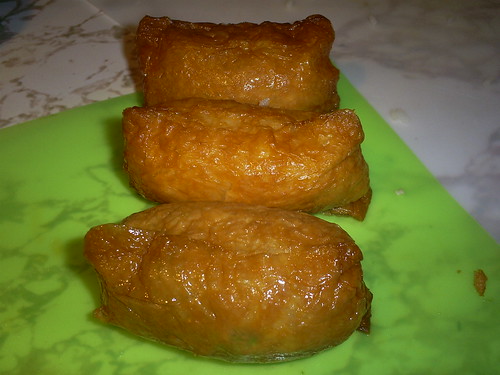
The first time I attempted to make sushi at home--given my lack of expertise--I picked up one of those exorbitantly-priced Annie Chun's sushi-making kits from the supermarket. I think it was $4 or $5, which isn't a lot of money in and of itself, but it is far too much to spend when you consider how much a big bag of sushi rice and a large package of nori costs. And that's "nori" as in the dried seaweed, not "Nouri" as in Michael Nouri, from TV's Damages.
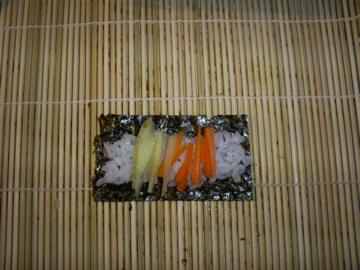
Annie Chun's sushi kit comes with a little microwaveable (or boil-able) container of rice, a few small strips of nori, and a little soy dipping sauce. If you're making sushi at home, this is a terrible value. As you can see in the picture above, at this point, I had no clue what I was doing. The filling of carrots and cukes is actually facing the wrong direction for properly rolling sushi--although this worked out okay for a first attempt.

Our first homemade sushi. The Annie Chun's package makes about twice as many as pictured here, total. My initial sushi-rolling process was pretty simple: lay out the nori, spread rice in the middle (for some reason I thought I should leave a little margin at the top and bottom, which wasn't that far off the mark), lay down veggies, and roll. This isn't entirely wrong, but it's not exactly the easiest or simplest way of rolling sushi, either.
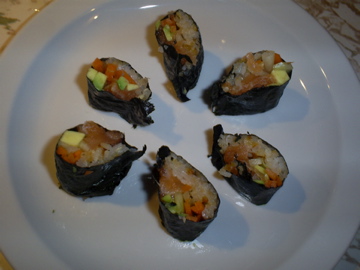
My second time making sushi at home, a few days after the first attempt, I used nori and sushi rice bought at a speciality Asian grocer. The results were more cost-effective than the initial batch, and the resultant rolls were admittedly not delicious, but not bad either. Through trial and error, I did a semi-decent job rolling the sushi (especially for my first time making whole sushi rolls, I think), and while I was left with a little excess nori, I was pretty pleased with the attempt.
The third time around, I tried my hand at making inside-out rolls, also known as uramaki. In these rolls, the filling is encircled by the nori, which is covered in rice and sesame seeds. See how much use we're getting out of sesame seeds these days? Between hummus and homemade sushi, you've got some pretty delicious food at the ready.
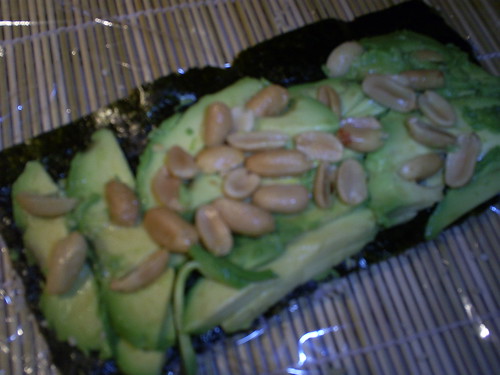
This first roll, taken from the menu of Osaka in Northampton, MA, contains sliced avocado and salted peanuts. One trick that I found online for inside-out roll making is to rest the rice-covered nori on a piece of plastic wrap, in order to prevent it from sticking to whatever surface you're working on (in this case, a small bamboo mat).
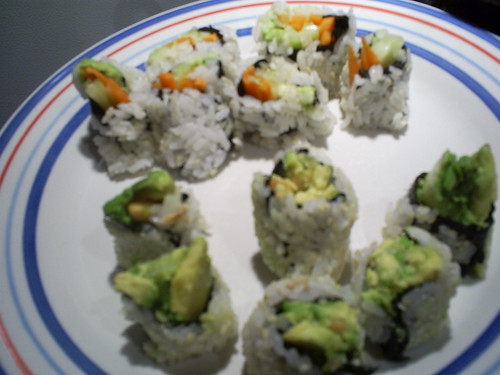
This Buddha roll and Veggie roll remind me a little of the Ancient Roman Senate. I picture the patricians divided over some issue or another, with the Buddha roll vehemently arguing against the Veggie roll contingent. Maybe you can see it if you squint a little.
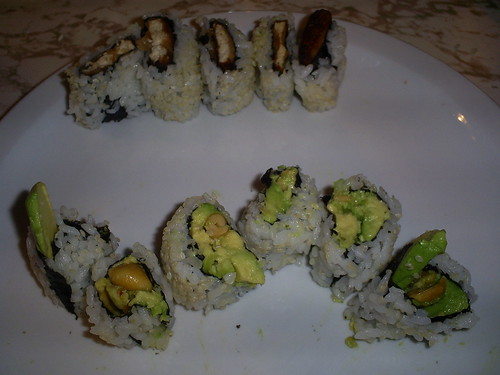
This batch of sushi was by no means perfectly rolled--and my sushi-cutting skills clearly need some work--but it was a significant improvement over the first two attempts, especially in terms of taste, and correct ratio of rice to nori to filling. The two rolls pictured here are the crunch roll (which simply contains tofu), and the above-mentioned Buddha roll. I did a little snake shape with the Buddha roll. You can sort of see it in the picture above. The desire to shape make my food look like animals is admittedly weird.

If you have leftover sushi rice (and I usually find that I do), one thing you can quickly and easily do with it is make inari. You can buy the tofu pouches for your inari in the refrigerated section of your local Asian grocery store, and then simply fill them with sushi rice and, in this case, leftover avocado.

Thanks for stopping by Beach City Cooking, and I'll see you all very soon for another post. Have a great Friday evening, and stay cool!

No comments:
Post a Comment